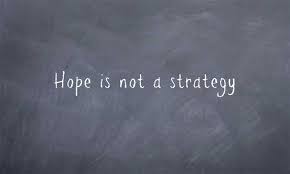There sure is a lot of hopeful and wishful thinking going on right now to improve performance. I hope;
- this pandemic would go away

- things would return to normal.
- my spouse and children leave me alone
- I don’t eat so much
- to lose some weight
- we can go on our planned holiday
- my favourite restaurant is open now.
- the concert we bought tickets to six months ago doesn’t cancel.
- I never participate in another virtual meeting
- I could get back to work at my office soon
- all our customers return
- and the “wishes and hopes to” go on and on.
Sound familiar?
There’s not a lot of action in hope strategy. Although it may be a welcome respite from the day-to-day direness projected by the news talking heads, but frankly, not for long.
You don’t build resilience by wishful and hopeful thinking. Resilience is an ability to recover from or adjust easily to misfortune or change. Resiliency is what you’ll need to get through this seemingly never-ending pandemic.
You build resiliency by skills training, conditioning drills and rehearsals. Think of your local football team. Other than match day, their weekly regimen includes skills training, conditioning drills and mental resilience.
What about our armed forces? Even when deployed, their daily regimen includes skills training, conditioning drills and tactical rehearsals.
Getting in to Top Gear
In these examples, the organisation developed a system to build resilience into the team by skills training, conditioning drills and rehearsals. Building resilience differentiates top-tier from bottom-tier businesses. For businesses to get to the top tier, they need to systemise skills training, conditioning drills and rehearsals. Top-tier businesses do this so the organisation can recover from or adjust easily to misfortune or change. They also gain efficiencies and effectiveness in closing their capability gap.
The capability gap for a business is the difference between operating at maximum potential versus underused or misused potential. Maximum potential means every member of the company, its leadership, team members, systems, technology, facilities and capacity are operating at top-most performance, and the outputs given, all the inputs have peaked.
In short, it means your business just can’t get anything more out of the organisation, given what it has. It’s tapped out! Systematise your business to build resilience and close the capability gap. And instead of wishful and hopeful thinking, climb these nine steps to position your business for peak performance.
9 Steps to Peak Performance
- Set your vision by asking yourself, “Why do I get up and come to this place? Why does my business exist?”
- Set your mission by asking, “What do we do, and for who? What makes my business so unique?”
- Develop a culture statement. The best companies operate mainly because of a consistent and robust culture.
- Define your goals by asking does the company have clear goals and does everyone in the business know what their goals are? Make your goals specific, measurable, attainable, results-oriented and time-framed.
- Create an organisation chart, which is a business system in itself. It should make reporting lines clear and provide clarity around each person’s role in the company and how they’re accountable.
- Establish position commitments. There should be a position commitment for every role in the business, and it should articulate why that job exists.
- Develop key performance indicators to track that the position commitments are being fulfilled.
- Design a procedures manual. Let everyone know what needs to happen in each area of the business. If one or more key people leave, the knowledge stays within your company.
- Develop management systems that take care of all your business systems and processes. Ensuring the business is resilient and continually striving to close the capability gap.
Hope is Not a Strategy
Wishful and hopeful thinking don’t close a business’ capability gap nor make it resilient. As frustrating as it may be, we’re still at the beginning of this pandemic. Business certainty will return once a therapeutic solution and vaccine are in place, likely in the new year. Even after these remedies are in effect, there will be other challenges businesses face that will test their resilience.
Systematising your business is how you gain entrance to the best of the best of companies, the top tier, and how you close your business’ capability gap.
Climb these nine steps to achieve peak performance! That’s how you lead, think, plan, and act.
So what next?
Well the first thing is to take action. This may look one of two ways.
- If you really haven’t considered any of the nine steps before then you should join Jeremy in a facilitated webinar. Here we will guide you through the points in detail. From there you will be able to create your path to success. Our next ‘9 Steps to Peak Performance’ webinar details can be found here.
- If you have some of these steps already taken care of but need to refine, review or finish these steps then a coaching session is the best step for you. ActionCOACH St Albans gifts five strategy coaching sessions a week to support businesses during the pandemic. In the session you will be able to see what over 230 other businesses have done differently. You will learn specific tactics and strategies for your business that you can apply immediately. Our session registration can be found here.
Armed with this knowledge of how to make your business as successful as you want it to be you will be best placed to make it happen. No wishes, no hope strategies. Just real results for real people.





